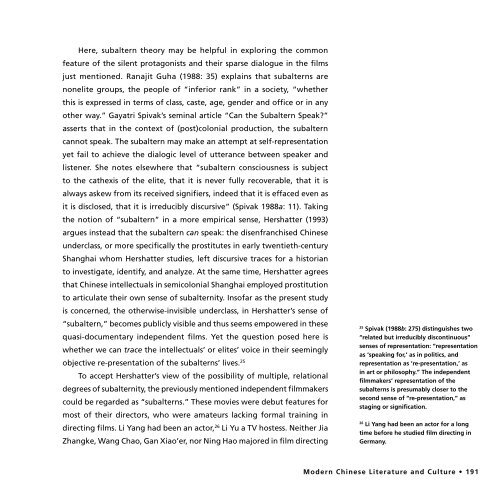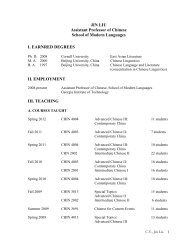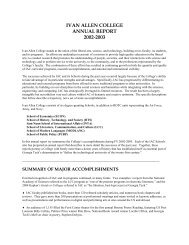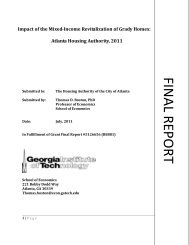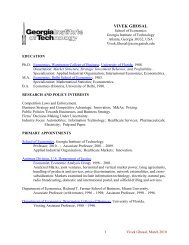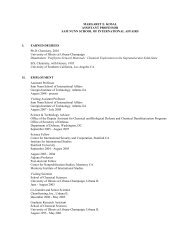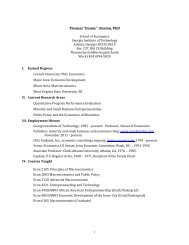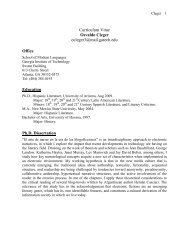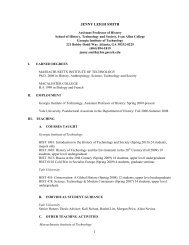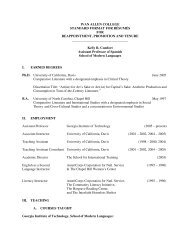Read this paper
Read this paper
Read this paper
You also want an ePaper? Increase the reach of your titles
YUMPU automatically turns print PDFs into web optimized ePapers that Google loves.
Here, subaltern theory may be helpful in exploring the common<br />
feature of the silent protagonists and their sparse dialogue in the films<br />
just mentioned. Ranajit Guha (1988: 35) explains that subalterns are<br />
nonelite groups, the people of “inferior rank” in a society, “whether<br />
<strong>this</strong> is expressed in terms of class, caste, age, gender and office or in any<br />
other way.” Gayatri Spivak’s seminal article “Can the Subaltern Speak?”<br />
asserts that in the context of (post)colonial production, the subaltern<br />
cannot speak. The subaltern may make an attempt at self-representation<br />
yet fail to achieve the dialogic level of utterance between speaker and<br />
listener. She notes elsewhere that “subaltern consciousness is subject<br />
to the cathexis of the elite, that it is never fully recoverable, that it is<br />
always askew from its received signifiers, indeed that it is effaced even as<br />
it is disclosed, that it is irreducibly discursive” (Spivak 1988a: 11). Taking<br />
the notion of “subaltern” in a more empirical sense, Hershatter (1993)<br />
argues instead that the subaltern can speak: the disenfranchised Chinese<br />
underclass, or more specifically the prostitutes in early twentieth-century<br />
Shanghai whom Hershatter studies, left discursive traces for a historian<br />
to investigate, identify, and analyze. At the same time, Hershatter agrees<br />
that Chinese intellectuals in semicolonial Shanghai employed prostitution<br />
to articulate their own sense of subalternity. Insofar as the present study<br />
is concerned, the otherwise-invisible underclass, in Hershatter’s sense of<br />
“subaltern,” becomes publicly visible and thus seems empowered in these<br />
quasi-documentary independent films. Yet the question posed here is<br />
whether we can trace the intellectuals’ or elites’ voice in their seemingly<br />
objective re-presentation of the subalterns’ lives. 25<br />
To accept Hershatter’s view of the possibility of multiple, relational<br />
degrees of subalternity, the previously mentioned independent filmmakers<br />
could be regarded as “subalterns.” These movies were debut features for<br />
most of their directors, who were amateurs lacking formal training in<br />
directing films. Li Yang had been an actor, 26 Li Yu a TV hostess. Neither Jia<br />
Zhangke, Wang Chao, Gan Xiao’er, nor Ning Hao majored in film directing<br />
25<br />
Spivak (1988b: 275) distinguishes two<br />
“related but irreducibly discontinuous”<br />
senses of representation: “representation<br />
as ‘speaking for,’ as in politics, and<br />
representation as ‘re-presentation,’ as<br />
in art or philosophy.” The independent<br />
filmmakers’ representation of the<br />
subalterns is presumably closer to the<br />
second sense of “re-presentation,” as<br />
staging or signification.<br />
26<br />
Li Yang had been an actor for a long<br />
time before he studied film directing in<br />
Germany.<br />
Modern Chinese Literature and Culture • 191<br />
MCLC 18.2.indd 191<br />
12/20/06 2:01:39 PM


